Influence of Excavation Radius on Behavior of Circular Foundation Pits Supported by Prefabricated Recyclable Structures: Full-Scale Experimental and Numerical Analysis
Abstract
:1. Introduction
2. Full-Scale Experimental Scheme
2.1. Site and Structure Description
2.2. Construction Process
2.3. Instrumentation
3. Numerical Simulation
3.1. Finite-Element Model and Boundary Conditions
3.2. Material Constitutive Model and Parameters
3.3. Simulation Procedures
4. Results and Discussion
4.1. Comparison of Experimental and Numerical Results
4.2. Influence of Excavation Radius on Deformations
4.2.1. Deflections of Supporting Piles
4.2.2. Ground Surface Settlements
4.2.3. Total Ground Movements
4.3. Influence of Excavation Radius on Stresses
4.3.1. Bending Moments of Supporting Piles
4.3.2. Earth Pressure
4.3.3. Circumferential Stress
4.4. Influence of Excavation Radius on Stability
5. Conclusions
- The deflection and bending moment of the supporting pile increase significantly with an increasing excavation radius; however, the increase rate gradually slows down, making the change in deflection and the bending moment insignificant when the excavation radius exceeds 50 m. Nevertheless, the excavation radius has little effect on the depth at which the maximum pile deflection and bending moment occur. In addition, the PSR value increases with an increasing excavation radius and gradually converges to 1.
- As with its influence on pile deflection, increasing the excavation radius results in greater ground surface settlement. Nevertheless, once the excavation radius is beyond 50 m, this influence becomes less pronounced, and the differences in ground surface settlement predictions using axisymmetric and planar strain models are minimal. Moreover, the distance from the maximum settlement point to the foundation pit increases with radius but stabilizes once the radius exceeds 30 m.
- In axisymmetric models, the lateral earth pressure on the non-excavation side of the supporting pile increases as the excavation radius increases. In excavation radii exceeding 50 m, the discrepancy between the earth pressures calculated using the axisymmetric and plane strain models is negligible.
- Circumferential stresses in the majority of the area affected by the excavation decrease with an increasing excavation radius. Once the excavation radius surpasses 50 m, its impact on circumferential stress becomes insignificant.
- When the radius of a circular foundation pit is less than 50 m, a larger excavation radius correlates with a smaller safety factor. However, when the excavation radius is more than 50 m, the safety factor under axisymmetric conditions remains constant and approaches that under plane strain conditions.
Author Contributions
Funding
Institutional Review Board Statement
Informed Consent Statement
Data Availability Statement
Conflicts of Interest
References
- Tan, Y.; Fan, D.; Lu, Y. Statistical Analyses on a Database of Deep Excavations in Shanghai Soft Clays in China from 1995–2018. Pract. Period. Struct. Des. Constr. 2022, 27, 4021067. [Google Scholar] [CrossRef]
- Hsiung, B.B.; Likitlersuang, S.; Phan, K.H.; Pisitsopon, P. Impacts of the plane strain ratio on excavations in soft alluvium deposits. Acta Geotech. 2021, 16, 1923–1938. [Google Scholar] [CrossRef]
- JGJ 120-2012; Technical Specification for Retaining and Protection of Building Foundation Excavations. China Architecture & Building Press: Beijing, China, 2012.
- Finno, R.J.; Blackburn, J.T.; Roboski, J.F. Three-Dimensional Effects for Supported Excavations in Clay. J. Geotech. Geoenviron. Eng. 2007, 133, 30–36. [Google Scholar] [CrossRef]
- Cheng, K.; Xu, R.; Ying, H.; Gan, X.; Zhang, L.; Liu, S. Observed performance of a 30.2 m deep-large basement excavation in Hangzhou soft clay. Tunn. Undergr. Space Technol. 2021, 111, 103872. [Google Scholar] [CrossRef]
- Galliková, Z.; Rehman, Z.U. Appraisal of the hypoplastic model for the numerical prediction of high-rise building settlement in Neogene clay based on real-scale monitoring data. J. Build. Eng. 2022, 50, 104152. [Google Scholar] [CrossRef]
- Liu, Y.; Huang, F.; Wang, G.; Cao, Y.; Li, B. Study on Long-Span and Variable-Section Foundation Pit Excavation in Muddy Silty Clay. Int. J. Civ. Eng. 2024, 22, 739–755. [Google Scholar] [CrossRef]
- Sun, Y.; Gu, Z.; Xu, Z.; Wang, C.; Song, D. Performance of a long, irregular top-down excavation in the centre of Nanjing, China. Proc. Inst. Civ. Eng. -Geotech. Eng. 2022, 177, 50–65. [Google Scholar] [CrossRef]
- Mana, A.I.; Clough, G.W. Prediction of Movements for Braced Cuts in Clay. J. Geotech. Eng. Div. 1981, 107, 759–777. [Google Scholar] [CrossRef]
- Wang, H. Influence of excavation width on enclosure-structure stability of foundation pits. China Civ. Eng. J. 2011, 44, 120–126. [Google Scholar] [CrossRef]
- Xiao, H.; Zhou, S.; Sun, Y. Wall Deflection and Ground Surface Settlement due to Excavation Width and Foundation Pit Classification. KSCE J. Civ. Eng. 2019, 23, 1537–1547. [Google Scholar] [CrossRef]
- Park, C.; Joung, S. Numerical investigations on the excavation width and property of deformation of earth retaining wall. J. Korean Geotech. Soc. 2020, 36, 57–68. [Google Scholar] [CrossRef]
- Tan, Y.; Wang, D. Characteristics of A Large-Scale Deep Foundation Pit Excavated by Central-Island Technique in Shanghai Soft Clay. Part II: Top-Down Construction of the Peripheral Rectangular Pit. J. Geotech. Geoenviron. Eng. 2013, 139, 1894–1910. [Google Scholar] [CrossRef]
- Zeng, C.; Zheng, G.; Zhou, X.; Xue, X.; Zhou, H. Behaviours of wall and soil during pre-excavation dewatering under different foundation pit widths. Comput. Geotech. 2019, 115, 103169. [Google Scholar] [CrossRef]
- Huang, P.; Dang, K.; Shi, H.; Yang, K.; Wu, J. Influence and Mechanism of the Excavation Width on Excavation Deformations in Shanghai Soft Clay. Buildings 2024, 14, 1450. [Google Scholar] [CrossRef]
- Kim, K.; Lee, D.; Cho, J.; Jeong, S.; Lee, S. The effect of arching pressure on a vertical circular shaft. Tunn. Undergr. Space Technol. 2013, 37, 10–21. [Google Scholar] [CrossRef]
- Schwamb, T.; Soga, K. Numerical modelling of a deep circular excavation at Abbey Mills in London. Géotechnique 2015, 65, 604–619. [Google Scholar] [CrossRef]
- Qiao, Y.; Xie, F.; Bai, Z.; Lu, J.; Ding, W. Deformation characteristics of ultra-deep circular shaft in soft soil: A case study. Undergr. Space 2024, 16, 239–260. [Google Scholar] [CrossRef]
- Tangjarusritaratorn, T.; Miyazaki, Y.; Sawamura, Y.; Kishida, K.; Kimura, M. Numerical investigation on arching effect surrounding deep cylindrical shaft during excavation process. Undergr. Space 2022, 7, 944–965. [Google Scholar] [CrossRef]
- Tobar, T.; Meguid, M.A. Experimental Study of the Earth Pressure Distribution on Cylindrical Shafts. J. Geotech. Geoenviron. Eng. 2011, 137, 1121–1125. [Google Scholar] [CrossRef]
- Herten, M.; Pulsfort, M. Determination of spatial earth pressure on circular shaft constructions. Granul. Matter 1999, 2, 1–7. [Google Scholar] [CrossRef]
- Tan, Y.; Wang, D. Characteristics of a Large-Scale Deep Foundation Pit Excavated by the Central-Island Technique in Shanghai Soft Clay. I: Bottom-Up Construction of the Central Cylindrical Shaft. J. Geotech. Geoenviron. Eng. 2013, 139, 1875–1893. [Google Scholar] [CrossRef]
- Cheng, Y.M.; Hu, Y.Y.; Wei, W.B. General Axisymmetric Active Earth Pressure by Method of Characteristics—Theory and Numerical Formulation. Int. J. Geomech. 2007, 7, 1–15. [Google Scholar] [CrossRef]
- Cho, J.; Lim, H.; Jeong, S.; Kim, K. Analysis of lateral earth pressure on a vertical circular shaft considering the 3D arching effect. Tunn. Undergr. Space Technol. 2015, 48, 11–19. [Google Scholar] [CrossRef]
- Meftah, A.; Benmebarek, N.; Benmebarek, S. Numerical study of the active earth pressure distribution on cylindrical shafts using 2D finite difference code. J. Appl. Eng. Sci. Technol. 2018, 4, 123–128. [Google Scholar]
- Liu, G.; Meng, H.; Song, G.; Bo, W.; Zhao, P.; Ning, B.; Xu, X. Numerical simulation of wedge failure of rock slopes using three-dimensional discontinuous deformation analysis. Environ. Earth Sci. 2024, 83, 310. [Google Scholar] [CrossRef]
- Zhang, J.; Li, Y.; Zhang, C. Pounding induced overturning resistance of FPB-isolated structures considering soil-structure-interactions. Soil Dyn. Earthq. Eng. 2024, 177, 108416. [Google Scholar] [CrossRef]
- Keshavarz, A.; Ebrahimi, M. Axisymmetric passive lateral earth pressure of retaining walls. KSCE J. Civ. Eng. 2017, 21, 1706–1716. [Google Scholar] [CrossRef]
- Guo, C.; Ye, J.; Zhao, C.; Wang, F. Mechanical and deformation characteristics of composite assembled supporting structure. Geotech. Res. 2020, 7, 230–243. [Google Scholar] [CrossRef]
- Hu, D.; Guo, C.; Chu, X. Case Study of Flexible Prefabricated Impermeable Underground Support Structure. Iran. J. Sci. Technol. Trans. Civ. Eng. 2021, 45, 2489–2501. [Google Scholar] [CrossRef]
- Huang, H.; Yuan, Y.; Zhang, W.; Li, M. Seismic behavior of a replaceable artificial controllable plastic hinge for precast concrete beam-column joint. Eng. Struct. 2021, 245, 112848. [Google Scholar] [CrossRef]
- Cao, J.; Du, J.; Fan, Q.; Yang, J.; Bao, C.; Liu, Y. Reinforcement for earthquake-damaged glued-laminated timber knee-braced frames with self-tapping screws and CFRP fabric. Eng. Struct. 2024, 306, 117787. [Google Scholar] [CrossRef]
- Pan, Y.; Fang, H.; Li, B.; Wang, F. Stability analysis and full-scale test of a new recyclable supporting structure for underground ecological granaries. Eng. Struct. 2019, 192, 205–219. [Google Scholar] [CrossRef]
- Chen, L.; Guo, C.; Cao, D. Numerical Investigation of Earth Berm Effects on Prefabricated Recyclable Supporting Structure in Circular Excavations. Appl. Sci. 2024, 14, 4703. [Google Scholar] [CrossRef]
- Huang, H.; Li, M.; Zhang, W.; Yuan, Y. Seismic behavior of a friction-type artificial plastic hinge for the precast beam–column connection. Arch. Civ. Mech. Eng. 2022, 22, 201. [Google Scholar] [CrossRef]
- Huang, H.; Li, M.; Yuan, Y.; Bai, H. Experimental Research on the Seismic Performance of Precast Concrete Frame with Replaceable Artificial Controllable Plastic Hinges. J. Struct. Eng. 2023, 149, 4022222. [Google Scholar] [CrossRef]
- GB 50497-2019; Technical standard for monitoring of building excavation engineering. Ministry Of Housing And Urban-Rural Development of the People’s Republic of China, China Architecture & Building Press: Beijing, China, 2019.
- Wang, F.; Chen, L.; Pan, Y.; Guo, C.; Guo, C.; Yue, L.; Chu, X. Deformation characteristics of excavation supported by prefabricated recyclable structures. Proc. Inst. Civ. Eng. -Geotech. Eng. 2024, ahead of print, 1–43. [Google Scholar] [CrossRef]
- Zhou, H.; Zheng, G.; He, X.; Wang, E.; Guo, Z.; Nie, D.; Ma, S. Numerical modelling of retaining structure displacements in multi-bench retained excavations. Acta Geotech. 2020, 15, 2691–2703. [Google Scholar] [CrossRef]
- Brinkgreve, R.; Kumarswamy, S.; Swolfs, W.M.; Waterman, D.; Chesaru, A.; Bonnier, P.G. PLAXIS 2016; PLAXIS bv: Delft, The Netherlands, 2016. [Google Scholar]
- Benz, T. Small-Strain Stiffness of Soils and Its Numerical Consequences; University of Sturrgart: Stuttgart, Germany, 2007. [Google Scholar]
- Zhang, W.; Goh, A.T.C.; Xuan, F. A simple prediction model for wall deflection caused by braced excavation in clays. Comput. Geotech. 2015, 63, 67–72. [Google Scholar] [CrossRef]
- Nejjar, K.; Dias, D.; Cuira, F.; Chapron, G.; Le Bissonnais, H. Numerical modelling of a 32 m deep excavation in the suburbs of Paris. Eng. Struct. 2022, 268, 114727. [Google Scholar] [CrossRef]
- Hardin, B.O.; Drnevich, V.P. Shear Modulus and Damping in Soils: Design Equations and Curves. J. Soil Mech. Found. Div. 1972, 98, 667–692. [Google Scholar] [CrossRef]
- Di Mariano, A.; Amoroso, S.; Arroyo, M.; Monaco, P.; Gens, A. SDMT-Based Numerical Analyses of Deep Excavation in Soft Soil. J. Geotech. Geoenviron. Eng. 2019, 145, 04018102. [Google Scholar] [CrossRef]
- Brinkgreve, R.B. Selection of soil models and parameters for geotechnical engineering application. In Soil Constitutive Models: Evaluation, Selection, and Calibration; American Society of Civil Engineers: Austin, TX, USA, 2005; pp. 69–98. [Google Scholar]
- Rehman, Z.U.; Zhang, G. Shear coupling effect of monotonic and cyclic behavior of the interface between steel and gravel. Can. Geotech. J. 2018, 56, 876–884. [Google Scholar] [CrossRef]
- Potyondy, J.G. Skin friction between various soils and construction materials. Géotechnique 1961, 11, 339–353. [Google Scholar] [CrossRef]
- GB/T 11263-2017; Hot-Rolled H Sections and Cut T Sections. S.A.O. of the People’s Republic Of China, China Architecture & Building Press: Beijing, China, 2017.
- Mishra, A.; Sawant, V.A. A Detailed Investigation on Contiguous Pile Wall with Homogeneous Backfill. Geotech. Geol. Eng. 2023, 41, 2065–2089. [Google Scholar] [CrossRef]
- Richards, D.J.; Clark, J.; Powrie, W. Installation effects of a bored pile wall in overconsolidated clay. Géotechnique 2006, 56, 411–425. [Google Scholar] [CrossRef]
- Duan, N.; Cheng, Y.P.; Liu, J.W. DEM analysis of pile installation effect: Comparing a bored and a driven pile. Granul. Matter 2018, 20, 1–16. [Google Scholar] [CrossRef]
- Ou, C.; Hsieh, P.; Chiou, D. Characteristics of ground surface settlement during excavation. Can. Geotech. J. 1993, 30, 758–767. [Google Scholar] [CrossRef]
- Ni, X.; Lu, J.; Wang, Y.; Shi, J.; Chen, W.; Tang, L. Field investigation of the influence of basement excavation and dewatering on ground and structure responses. Tunn. Undergr. Space Technol. 2021, 117, 104121. [Google Scholar] [CrossRef]
- Feng, Z.; Xu, Q.; Xu, X.; Tang, Q.; Li, X.; Liao, X. Deformation Characteristics of Soil Layers and Diaphragm Walls during Deep Foundation Pit Excavation: Simulation Verification and Parameter Analysis. Symmetry 2022, 14, 254. [Google Scholar] [CrossRef]
- Ou, C.; Chiou, D.; Wu, T. Three-Dimensional Finite Element Analysis of Deep Excavations. J. Geotech. Eng. 1996, 122, 337–345. [Google Scholar] [CrossRef]
- Lu, T.; Wu, K.; Liu, S.; Cai, G. Method for estimating three-dimensional effects on braced excavation in clay. Tunn. Undergr. Space Technol. 2023, 141, 105355. [Google Scholar] [CrossRef]
- Zhao, J.; Tan, Z.; Yu, R.; Li, Z.; Zhang, X.; Zhu, P. Deformation responses of the foundation pit construction of the urban metro station: A case study in Xiamen. Tunn. Undergr. Space Technol. 2022, 128, 104662. [Google Scholar] [CrossRef]
- Maher, T.; Basha, A.M.; Abo-Raya, M.M.; Zakaria, M.H. General deformation behavior of deep excavation support systems: A review. Glob. J. Eng. Technol. Adv. 2022, 10, 39–57. [Google Scholar] [CrossRef]
- Yang, K.; Li, Z.; Chen, Y.; Yang, X.; Lin, W. Soil Arching–Induced Lateral Earth Pressure Redistribution on the Retaining Wall in a Multistrutted Excavation in Soft Soil. J. Geotech. Geoenviron. Eng. 2023, 149, 5023004. [Google Scholar] [CrossRef]
- Schanz, T.; Vermeer, P.A.; Bonnier, P.G. Formulation and verification of the Hardening-Soil Model. In Beyond 2000 in Computational Geotechnics; Routledge: Rotterdam, The Netherlands, 1999. [Google Scholar]
- Xiong, G.; Wang, J. A rigorous characteristic line theory for axisymmetric problems and its application in circular excavations. Acta Geotech. 2020, 15, 439–453. [Google Scholar] [CrossRef]
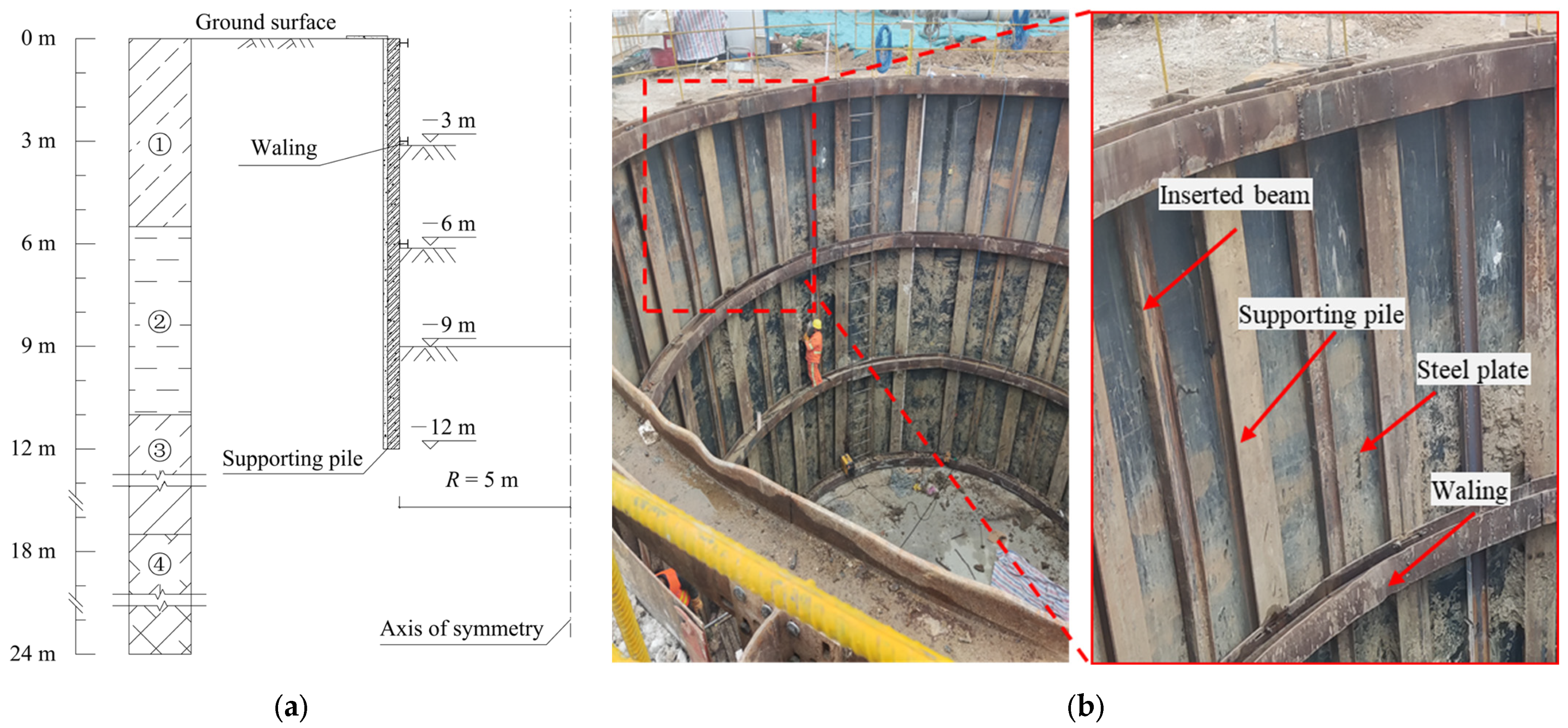
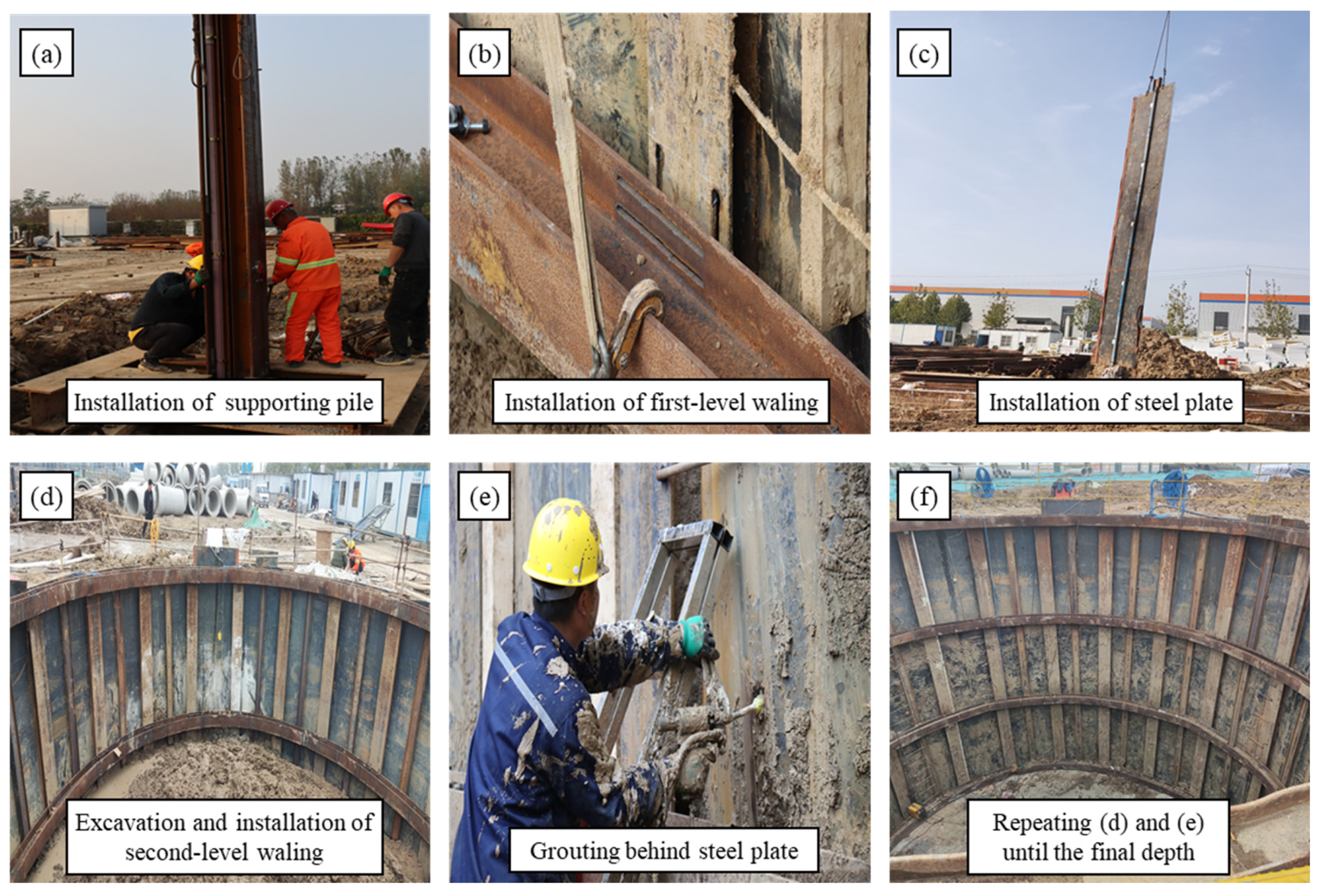
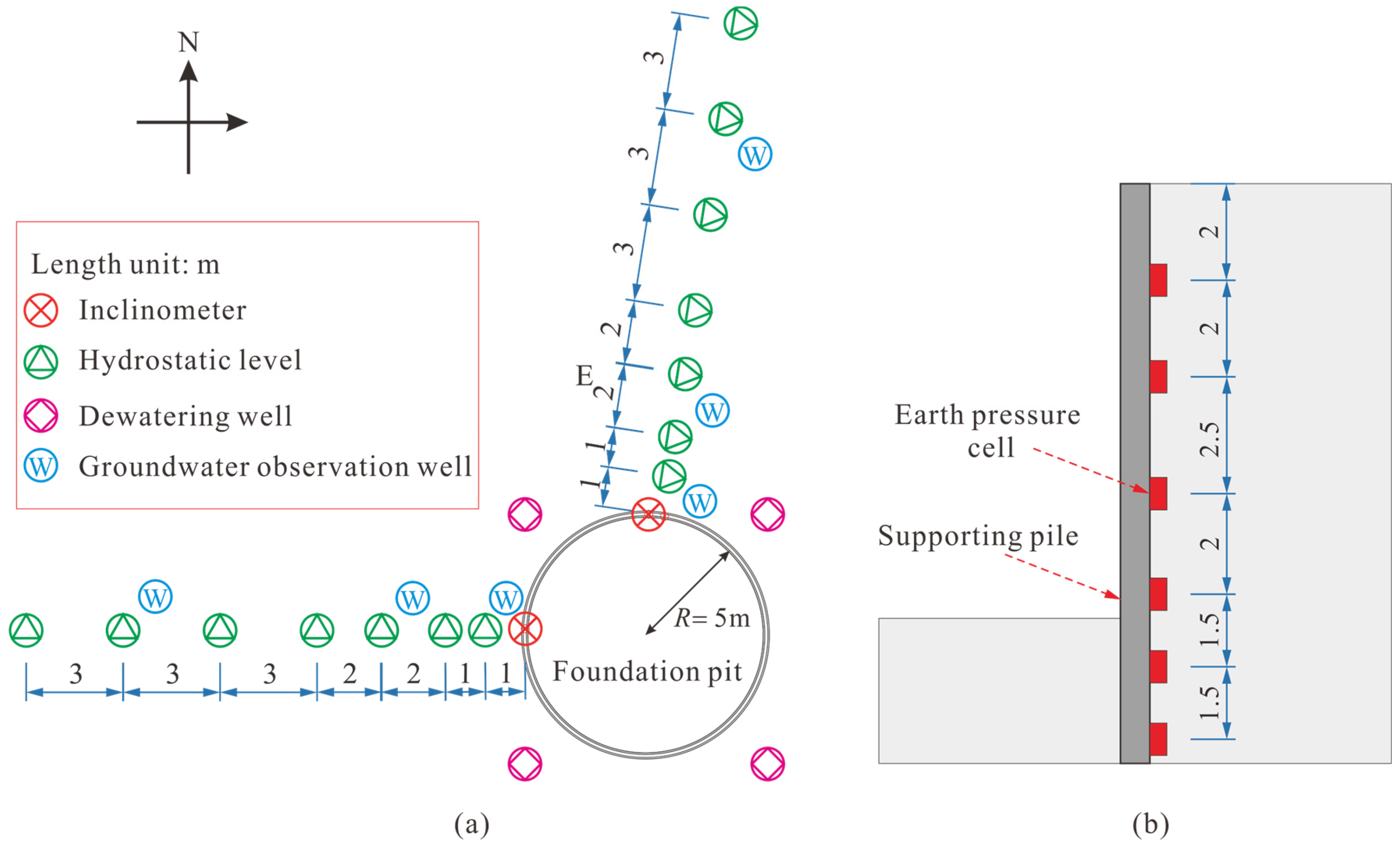
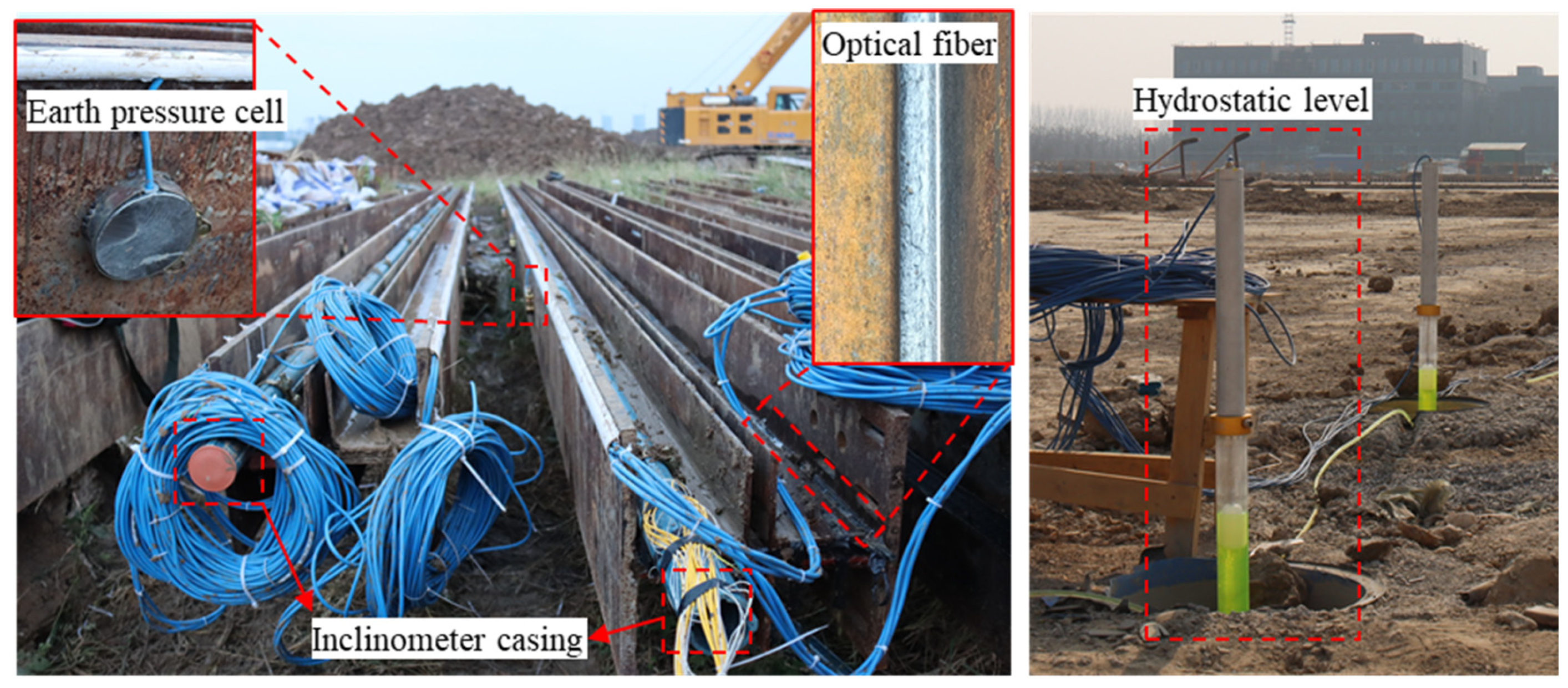

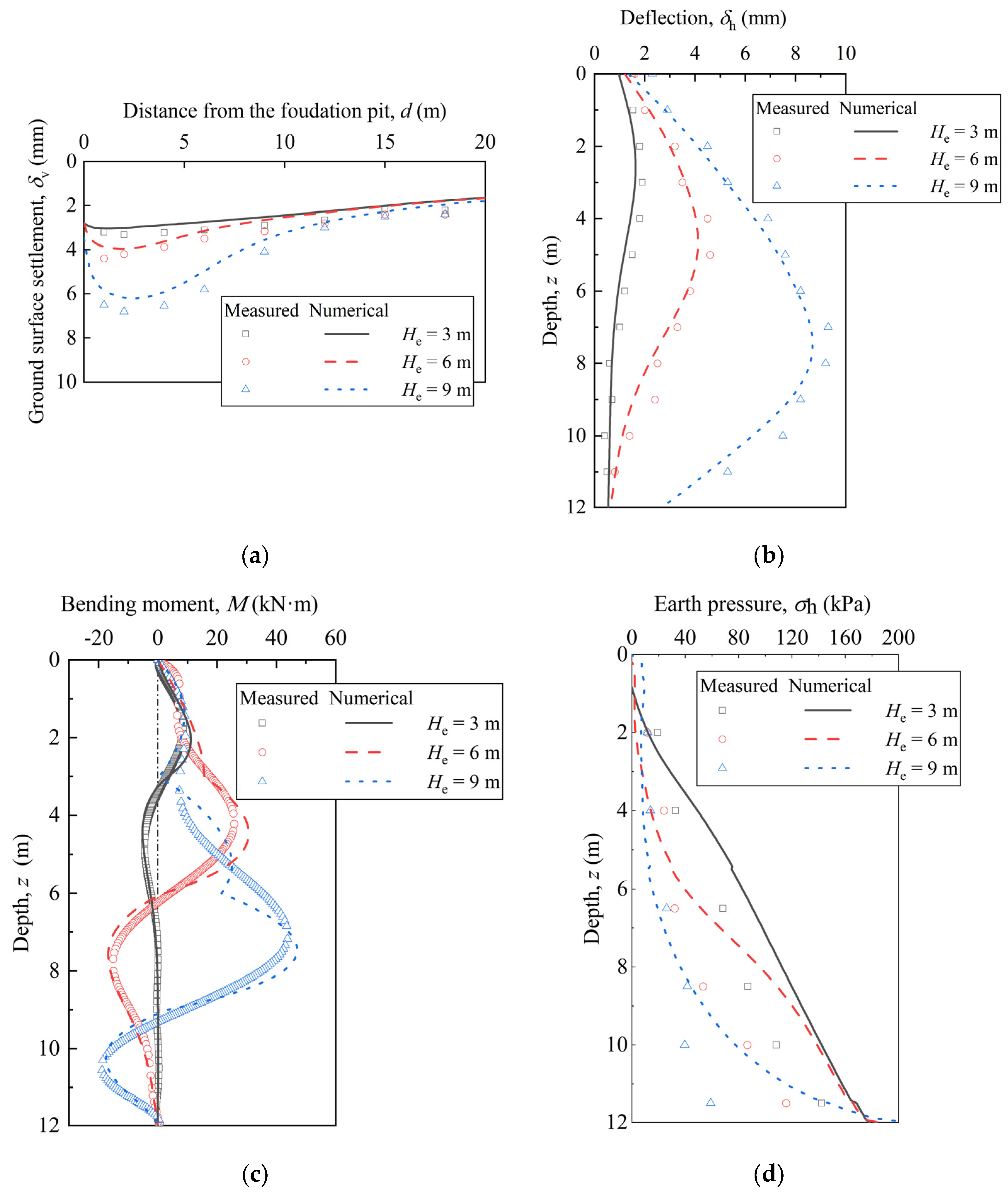
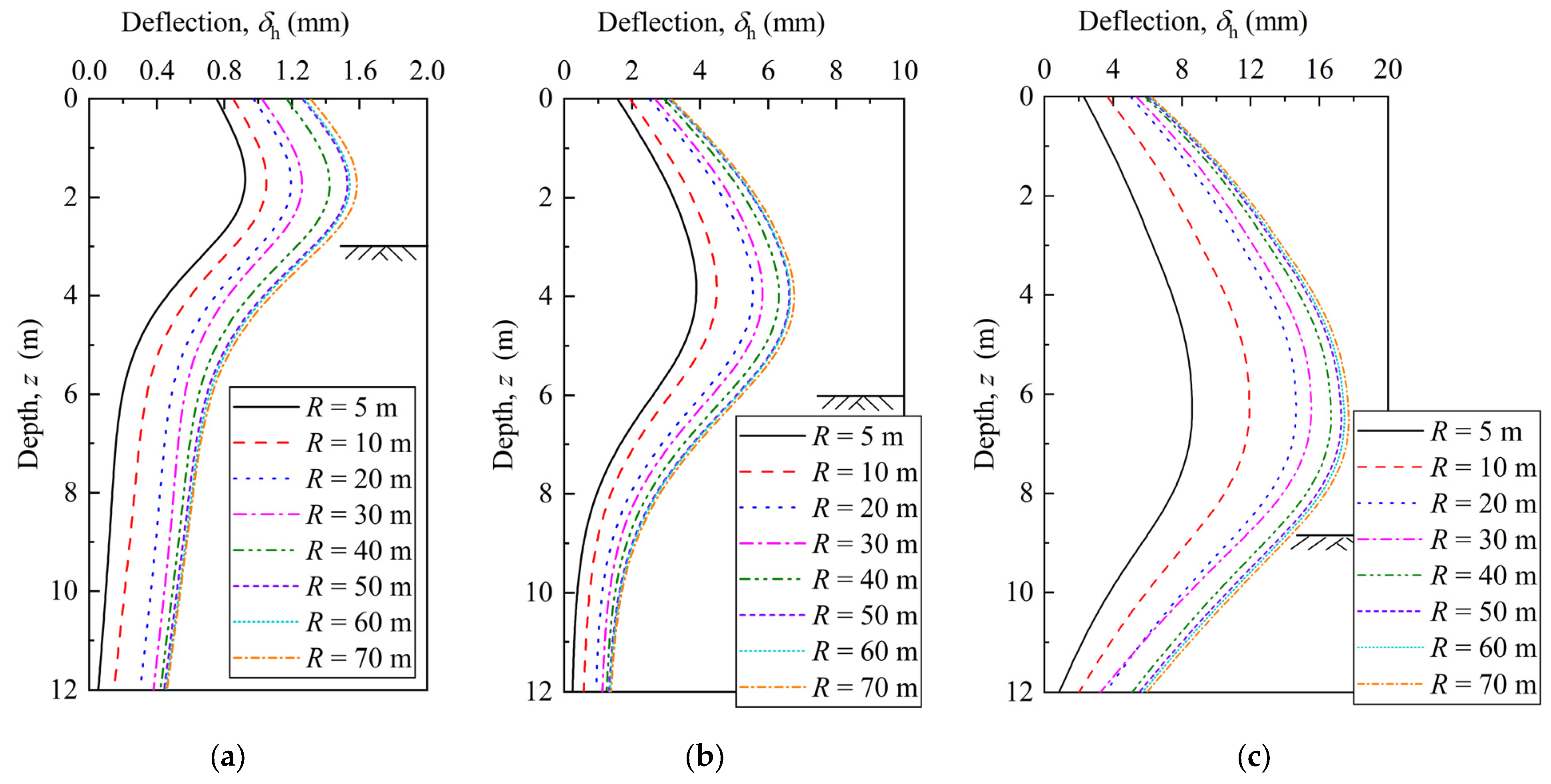
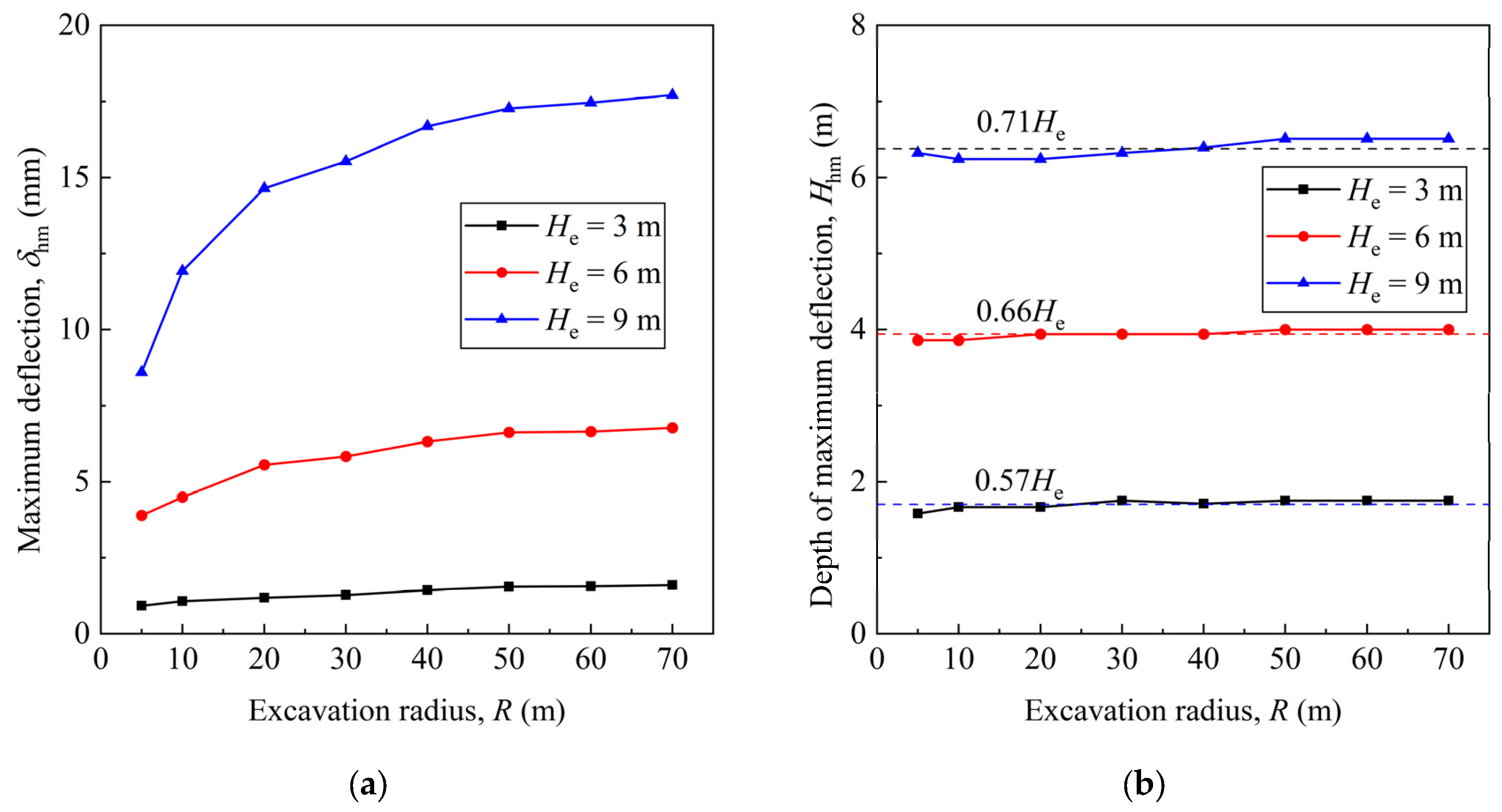




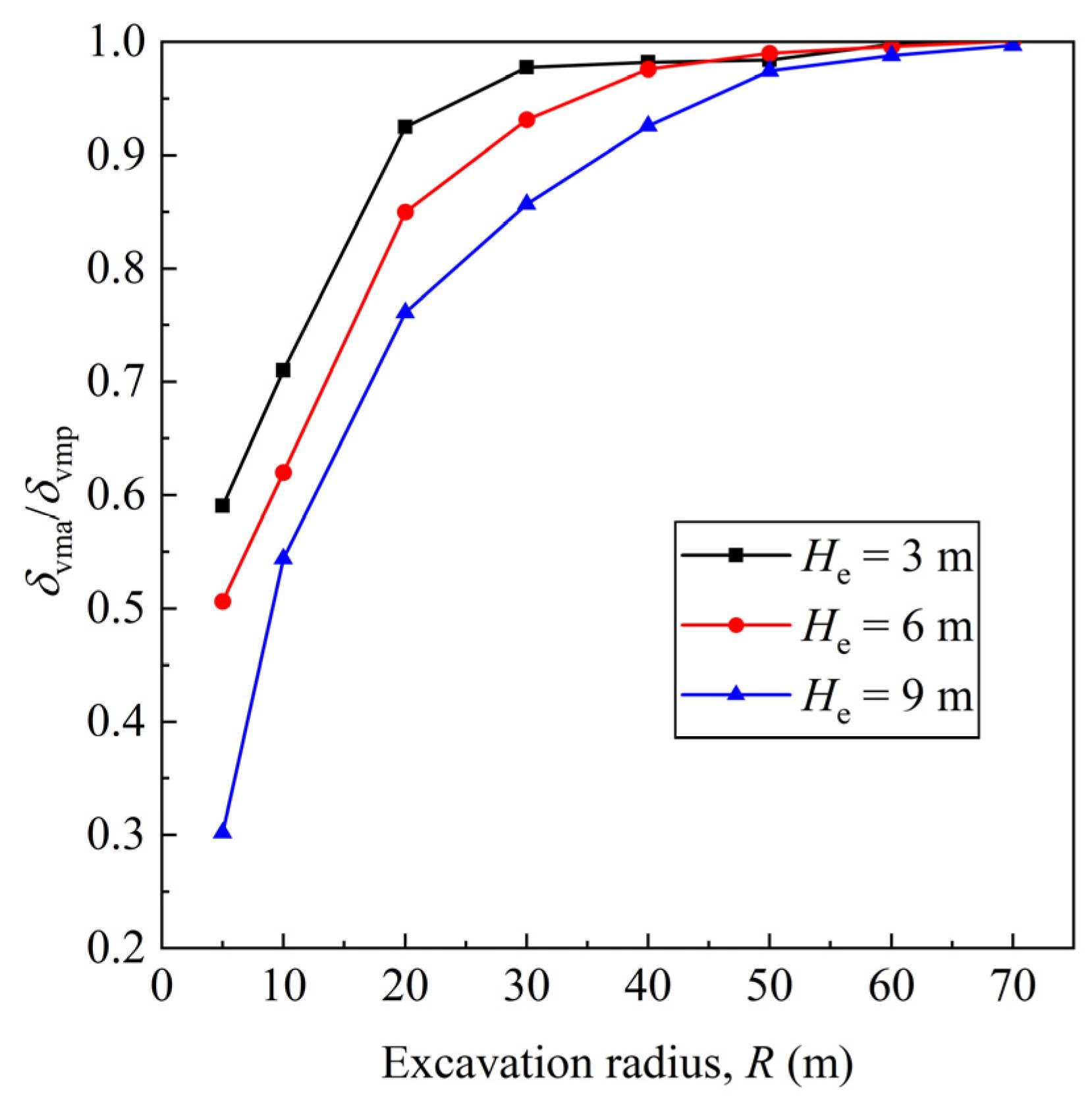
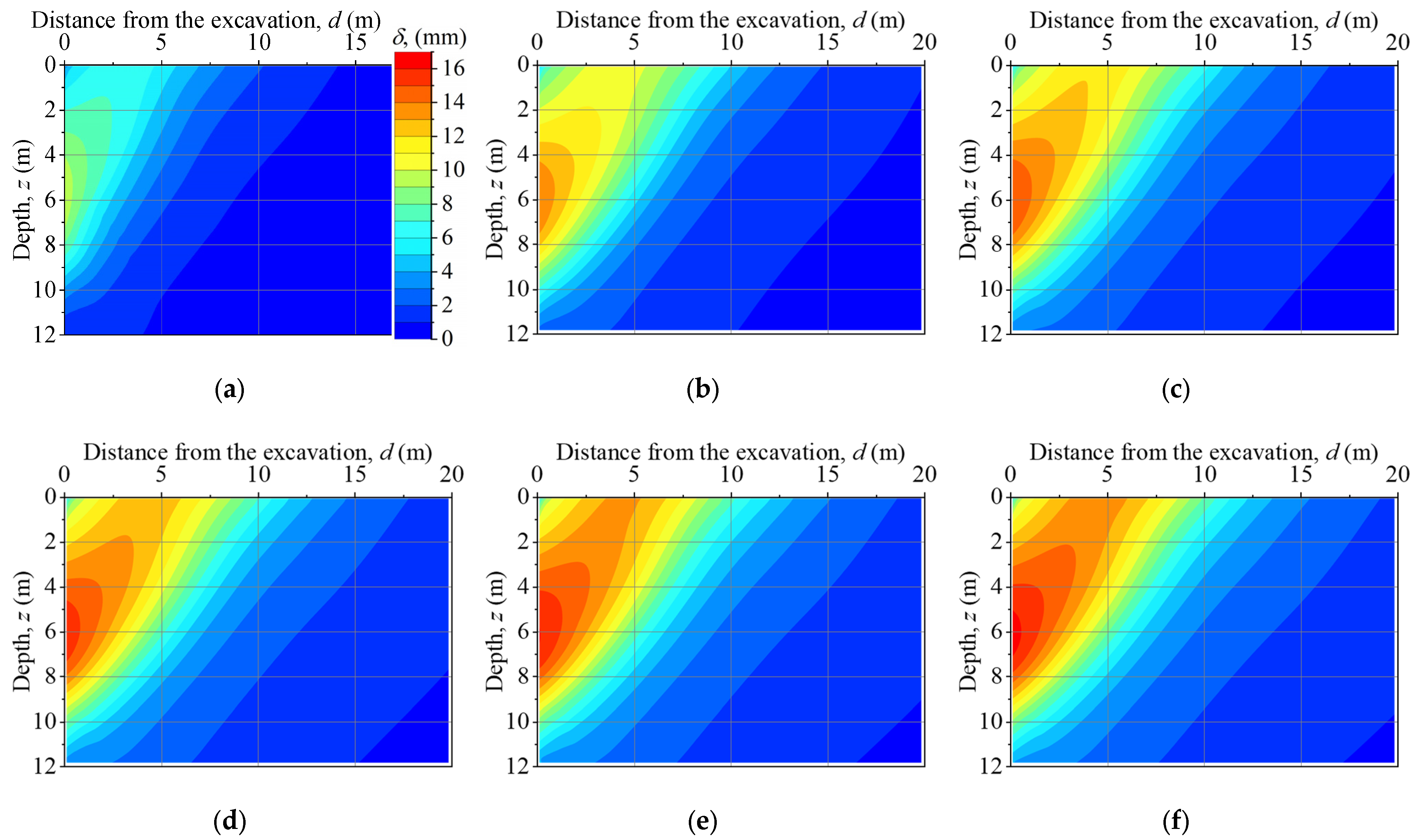




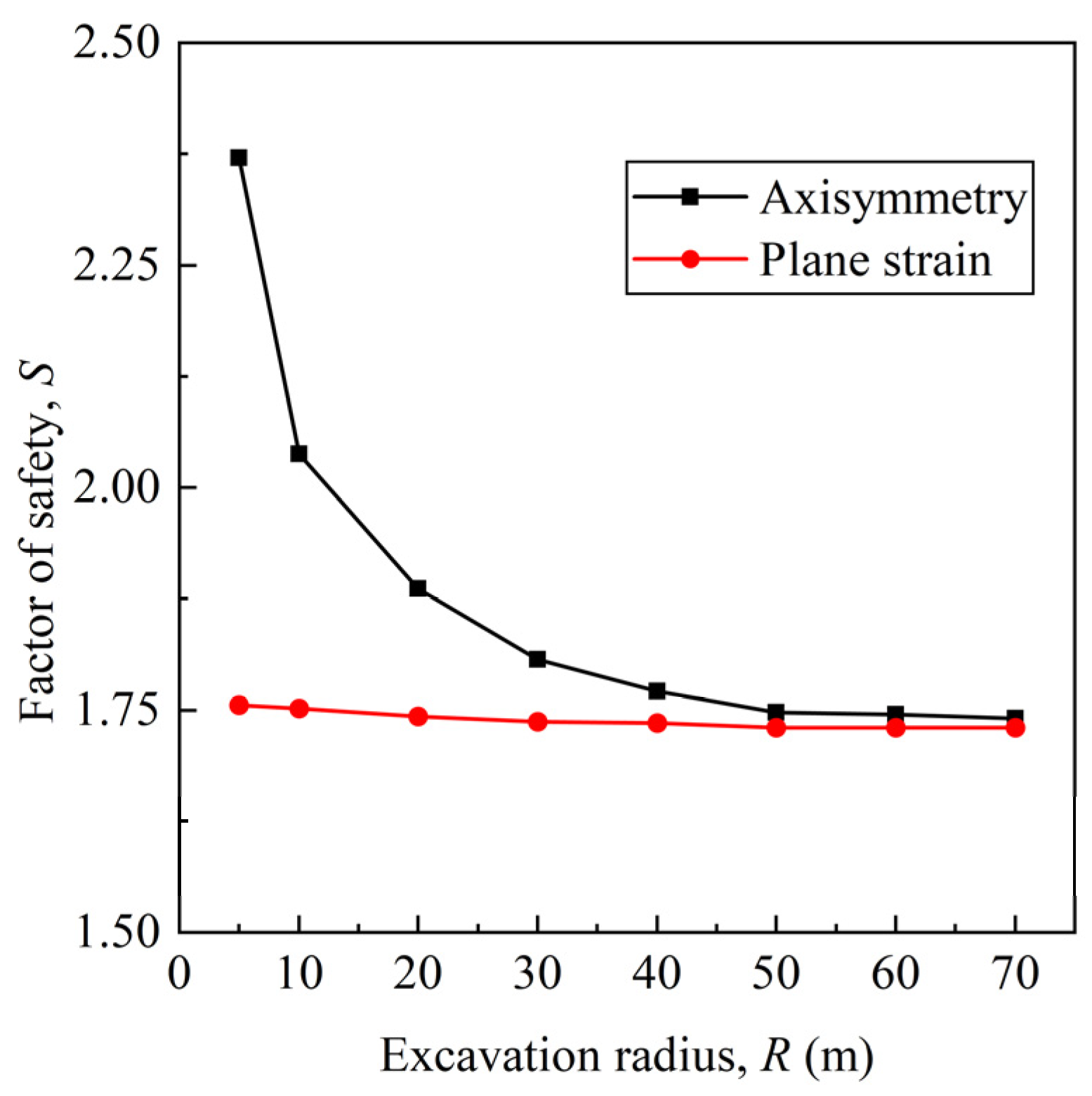
| Soil Layers | Unit Weight, γ (kN/m3) | Water Content, w (%) | Void Ratio, e | Effective Cohesion, c’, (kPa) | Effective Friction Angle, φ’ (°) | Plasticity Index, IP (%) | Liquidity Index, IL | Compression Modulus, Es (MPa) | Cone Resistance in CPT, qc (MPa) | Blow Count of SPT, N | Permeability Coefficient, Κ (m/day) |
|---|---|---|---|---|---|---|---|---|---|---|---|
| ① | 19.18 | 23.6 | 0.719 | 28.5 | 13.3 | 12.7 | 0.38 | 7.76 | 1 | 4.5 | 0.08 |
| ② | 19.43 | 23.8 | 0.704 | 31.6 | 14.2 | 13.9 | 0.33 | 8.09 | 1.3 | 10.3 | 0.08 |
| ③ | 19.18 | 24.7 | 0.738 | 30.8 | 13.4 | 13.9 | 0.33 | 8.37 | 2.2 | 8.9 | 0.12 |
| ④ | 19.38 | 23.3 | 0.702 | 31.5 | 14.6 | 13.8 | 0.29 | 9.01 | 1.8 | 16.4 | 0.09 |
| Soil Layers | Tangent Referential Stiffness, (MPa) | Secant Referential Stiffness, (MPa) | Unloading –Reloading Referential Stiffness, (MPa) | Poisson’s Ratio for Unloading-Reloading, | Reference Shear Modulus at Very Small Strains, (kN/m2) | Shear Strain for 70% of G0, (10−4) | Power for Stress-Level Dependency of Stiffness, | Failure Ratio, | Interface Reduction Factor, |
|---|---|---|---|---|---|---|---|---|---|
| ① | 7.76 | 7.76 | 23.28 | 0.2 | 97.27 | 2.59 | 1.0 | 0.9 | 0.65 |
| ② | 8.09 | 8.09 | 24.27 | 0.2 | 99.44 | 2.48 | 1.0 | 0.9 | 0.65 |
| ③ | 8.37 | 8.37 | 25.11 | 0.2 | 94.59 | 2.62 | 1.0 | 0.9 | 0.65 |
| ④ | 9.01 | 9.01 | 27.03 | 0.2 | 99.73 | 2.87 | 1.0 | 0.9 | 0.65 |
| Structural Element | Element Type | Material Type | Axis Stiffness of the Anchor or the In-Plane Axis Stiffness of the Plate EA1 (kN) | Out-of-Plane Axis Stiffness, EA2 (kN) | Flexural Rigidity EI (kN·m2) | Spacing of Supporting Piles Lspacing (m) |
|---|---|---|---|---|---|---|
| Supporting structure | Plate | Elastic | 2.31 × 106 | 0 | 5.22 × 104 | -- |
| Waling | Anchor | Elastic | 1.43 × 105 | -- | -- | 1.57 |
Disclaimer/Publisher’s Note: The statements, opinions and data contained in all publications are solely those of the individual author(s) and contributor(s) and not of MDPI and/or the editor(s). MDPI and/or the editor(s) disclaim responsibility for any injury to people or property resulting from any ideas, methods, instructions or products referred to in the content. |
© 2024 by the authors. Licensee MDPI, Basel, Switzerland. This article is an open access article distributed under the terms and conditions of the Creative Commons Attribution (CC BY) license (https://creativecommons.org/licenses/by/4.0/).
Share and Cite
Chen, L.; Guo, C.; Pan, Y.; Liang, H.; Tang, M.; Zhai, K. Influence of Excavation Radius on Behavior of Circular Foundation Pits Supported by Prefabricated Recyclable Structures: Full-Scale Experimental and Numerical Analysis. Buildings 2024, 14, 3110. https://doi.org/10.3390/buildings14103110
Chen L, Guo C, Pan Y, Liang H, Tang M, Zhai K. Influence of Excavation Radius on Behavior of Circular Foundation Pits Supported by Prefabricated Recyclable Structures: Full-Scale Experimental and Numerical Analysis. Buildings. 2024; 14(10):3110. https://doi.org/10.3390/buildings14103110
Chicago/Turabian StyleChen, Lichao, Chengchao Guo, Yanhui Pan, Huqing Liang, Mengxiong Tang, and Kejie Zhai. 2024. "Influence of Excavation Radius on Behavior of Circular Foundation Pits Supported by Prefabricated Recyclable Structures: Full-Scale Experimental and Numerical Analysis" Buildings 14, no. 10: 3110. https://doi.org/10.3390/buildings14103110






